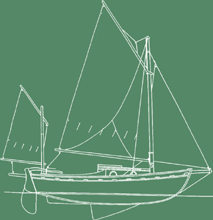Courtney here - driving around lately, I've been thinking about how good it is to live in a part of the world with such an abundance of natural beauty. Last night when I drove out to Wavey Creek to work on the boat, there was a very strong south wind blowing and the ground-drift (I'm talking snow, for those of you in warmer climes!) was spectacular. Its eerie, snakelike, shifting strands of windblown snow, which at times completely obscured the highway lane markers, reminded me in shape and form of some spectacular aurora, albeit on fast-forward. It was pretty cool in every sense of the word.
And this morning, driving to work, I was struck once again (it happens a lot in the winter around here) by the magnificent, understated, almost hallucinatory clarity of the prairie sky in winter. The wash of orange and gold at sunrise, the subtle gradations of purple and pink and grey on an early evening horizon... I don't think there's any way to capture these visions, though William Kurelek's watercolours come close.
Learned a bit about the power of moisture in wood, too. Most of the boards we bought (see earlier posts) for building were kiln-dried and stored inside, so they were dimensionally stable. The cheap cedar packing for the centre-plate case was not. Dad didn't think it would be a problem (famous last words!).
When we took the clamps off the CP-case sides, though, the top framing opposite the packing was bent and cracked. The cedar - a relatively small piece - had dried and bent the plywood, which in turn bent and cracked the mahogany framing. No huge deal to fix; we chiseled off the broken part, cleaned up the old epoxy, fit a new piece of framing... and clamped the sucker down onto the table-saw top to keep it flat. Of course, the packing board had to give, and it cracked down the centre, but that's no big deal; it's not structural, and it's going to be completely saturated with epoxy anyway. But at least the CP-case will be straight!

We also cut the "apron" out of a jeezly big plank of douglas fir. The apron is a kind of proto-stem that sits behind the externally visible stem; it's formed from two pieces and will be faced with marine plywood cheeks before being bevelled to fit the hull planking. It's a very "boaty" piece and gave me a bit of a thrill of accomplishment when we put it together. It was hard to clamp, though: we ended up holding both pieces in place with nails (a workbench made of old boxcar bottoms is a forgiving thing!) and using a wedge to drive the two pieces together. You can see the clamped joint in this photo - note the wedge at the far right.

And that's about it for now!











